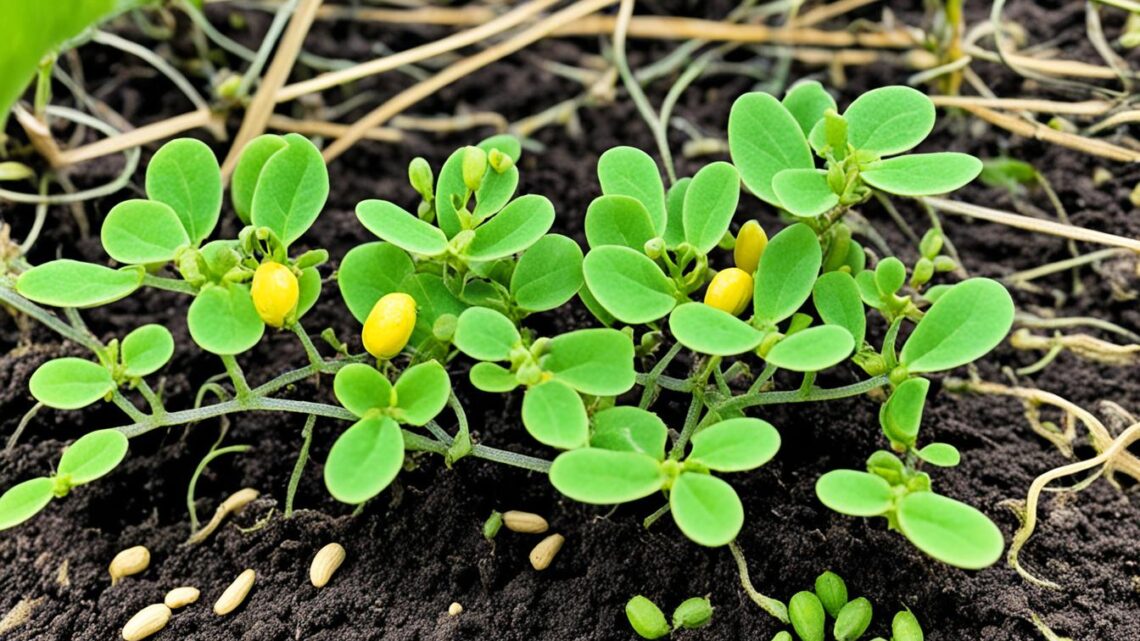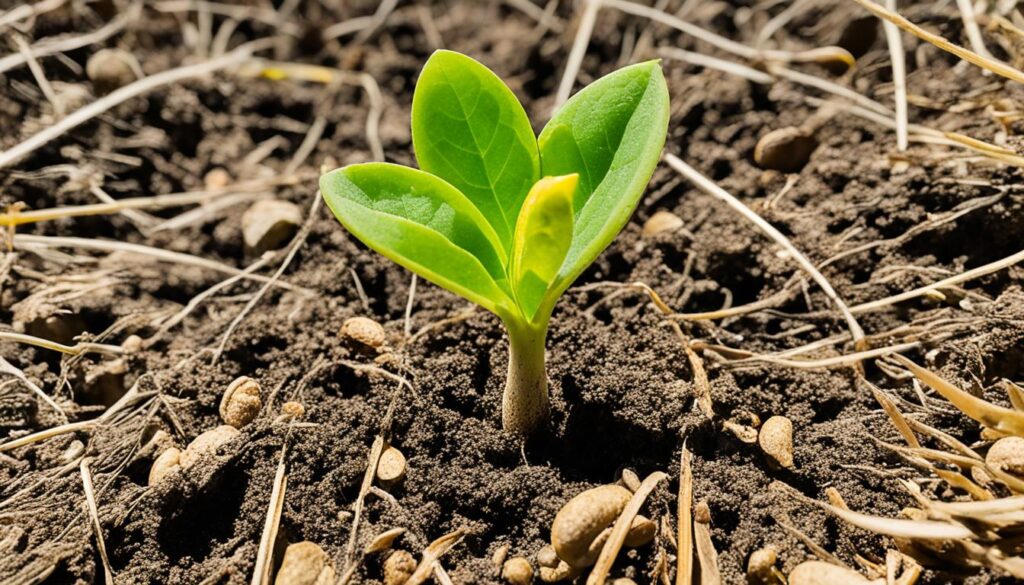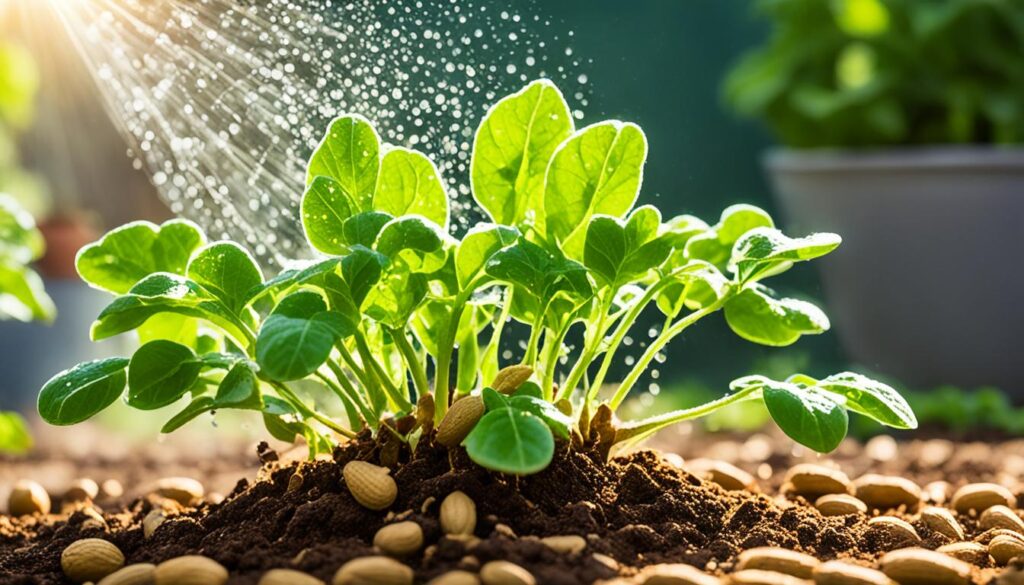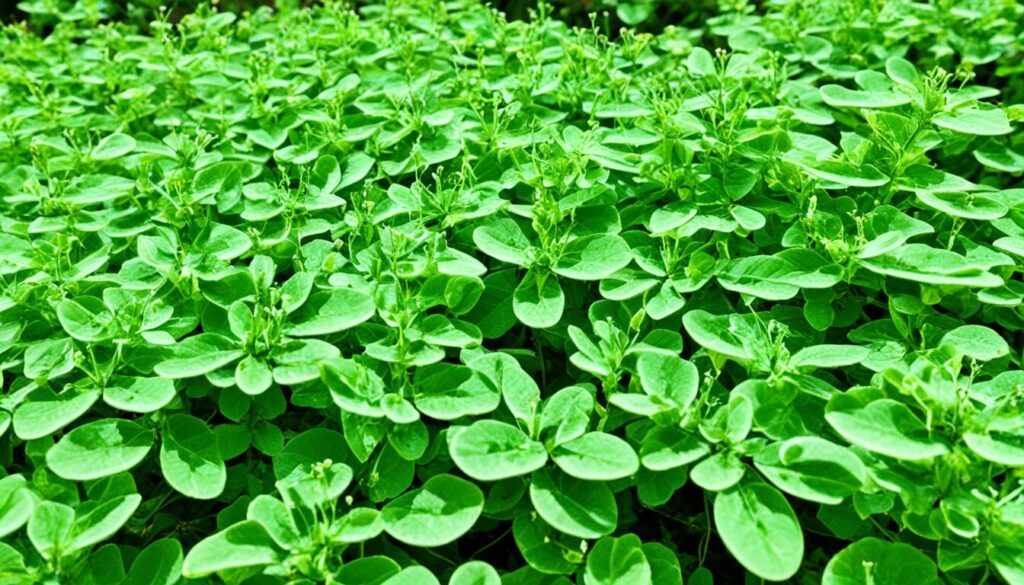
Ever thought about growing your own peanuts in the UK? It might not seem like an obvious choice. Yet, with the right information and dedication, it’s very doable. Growing your own peanut plant is possible, even in cooler areas. But, what do you need to know to get started? Let’s dive into the secrets of a successful peanut harvest at home, whether in your garden or a container.
Introduction to Peanut Cultivation
Peanuts go by many names like groundnuts, earthnuts, or monkey nuts. They are not nuts though; they are part of the legume family, like peas and beans. A special thing about them is how they grow. Their plant has roots that push down into the ground, where the pods grow.
What are Peanuts?
Peanuts are crucial for their edible seeds. They’re packed with protein, healthy fats, vitamins, and minerals. You find them in many foods, like peanut butter, snacks, confections, and oils. Peanuts are used in lots of global dishes, making them a beloved ingredient.
Origins and Cultivation of Peanuts
The peanut plant started in South America more than 3,500 years ago. Peruvian Indians were the first to grow it. From there, it spread worldwide. Today, countries in warm climates like China, India, Nigeria, and the United States grow peanuts. In the U.S., states such as Georgia, Florida, and Texas are top peanut growers.
Over time, growing peanuts has gotten better. New types have been made to fight diseases and boost quality. Farmers use smart rotations and methods to grow better peanuts and keep the soil healthy. This has led to a big industry that helps many communities around the world.
| Top Peanut Producing Countries | Production (tonnes) |
|---|---|
| China | 18,000 |
| India | 7,500 |
| Nigeria | 3,200 |
| United States | 2,900 |
Choosing the Right Peanut Variety
Choosing the right peanut variety is key to a successful and rich harvest. There are several types of peanuts, each unique. They suit different cooking and farming needs.
The Virginia type is top pick for many. Their large shells and great taste, along with high yields, make them perfect for snacks or dishes. The Valencia type is great for boiling because of its special flavor and red seeds.
The Spanish type is smaller and used in candies. It has more oil and a reddish skin. The Runner type is ideal for peanut butter. It grows low and has small bits with a good taste.
| Peanut Variety | Characteristics | Maturity Period | Best Uses |
|---|---|---|---|
| Virginia | Large shells, high yields, great flavor | 130-150 days | Snacking, cooking |
| Valencia | 3-5 seeds per pod, red seed coats, distinctive flavor | 90-110 days | Boiling |
| Spanish | Smaller kernels, higher oil content, reddish-brown skin | 90-120 days | Peanut candies, snacks |
| Runner | Prostrate growth habit, small kernels, excellent flavor | 130-150 days | Peanut butter |
When picking the best peanut variety, look at when they mature, how much they yield, and what you want them for. Choosing the right cultivar will improve your harvest and give the best taste and use.
Site Selection and Soil Preparation
Growing peanuts successfully needs the right spot and soil prep. They like warm spots with at least 120 to 150 days without frost. The best places are in the south of the U.S.
Ideal Growing Conditions
Peanuts love well-drained, slightly acidic soil that’s sunny. If your soil is heavy clay, mix in some compost. Don’t plant in spots that get waterlogged.
Soil Requirements
Peanuts do best in light, sandy soil. But, you can mix compost into your soil if it’s different. Aim for a soil pH between 6.5 and 7.0. In colder areas, you can warm the soil with plastic or by using a raised bed.
Give peanut plants 1 to 1.5 inches of water every week. This is especially important when the nuts are growing. Also, putting mulch around your plants can keep the soil moist and help stop weeds.

Pick the right site and treat the soil well to grow great peanuts. Remember, the key is to meet their needs for soil and location to get a good crop.
How to Grow a Peanut Plant
Planting Peanut Seeds
Planting peanuts is easy but needs the right timing. Do it in late spring or early summer when frost is gone and the soil is warm. Dig the seeds into the soil about 3-5 cm, with 30-45 cm space in between.
Just make a shallow hole, drop the seeds in, and cover with soil. Give them a good soak and don’t let the soil dry out. This keeps the peanut plants happy.
Care and Maintenance
Once the plants start growing, they’ll send out runners that bury peanuts in the ground. Create a soft bed at their roots with straw or mulch. This helps the peanut pegs and keeps moisture in the soil.
When planting, a bit of balanced fertilizer helps. But don’t overdo it. Follow the label and be gentle. Too much can harm the plants.
Keep the ground moist, especially during dry times. Consistent water makes for good growth conditions. Soon, you’ll have your own peanuts to enjoy.

Peanut Plant Growth Stages
Peanut plants are wonderful to watch as they grow. They start with pretty yellow flowers that look like peas. These flowers don’t need help to make seeds.
After pollen from a flower reaches another, the petals drop off. A special part called a «peg» grows down, poking the seed into the ground. This seed becomes a peanut.
Flowering and Pegging Process
The peanut in the soil starts as a tiny bump at the end of the peg. This bump grows into a peanut pod. This process is very important for growing peanuts and takes 4 to 5 months.
About 10 days after planting, peanut plants pop up. They grow up to 18 inches high and get green leaves. After about 40 days, white flowers start to show. Each plant can make about 40 pods.
Peanuts do more than just grow pods. Their roots have special spots that take in nitrogen. This makes the soil and plants around the peanuts healthier. It’s one of the reasons why peanuts are good for farms that want to use less chemicals.

As peanuts grow, they need a lot of water. This is most important when the seeds are developing. They need about 1.5 to 2 inches of water every week. That’s like 3.2 gallons of water to make one ounce of peanuts. This shows they use water wisely. For example, almonds need much more water.
Learning how peanuts grow helps people farm them better. They can make sure the plants have what they need. This helps lead to a big peanut harvest.
Peanut Plant Care and Maintenance
To keep peanut plants healthy, proper care is vital. A key part is making sure they get enough peanut watering. Water is crucial for growing peanuts. It’s essential to adjust moisture levels throughout the plant’s stages.
Watering Requirements
Starting with peanut seeds, the soil should always be a bit wet. This helps all seeds grow at the same rate. Be careful to water just the soil, not the leaves. Wet leaves can cause illness in the plant. The most important time to water is when the peanuts are forming below the ground. At this point, they need consistent care and lots of water.
But, it’s not good to water them too close to harvest time. Try to stop 10 to 14 days before you plan to pick them. Letting the plants dry a bit makes picking the pods much easier.
| Peanut Growth Stage | Watering Requirements |
|---|---|
| Germination | Keep soil consistently moist |
| Peg Penetration and Pod Development | Water 2-4 times per week |
| Pre-Harvest | Stop watering 10-14 days before harvest |
For a strong peanut crop, continue to water them well. Knowing how much water the peanuts need is key. This way, gardeners can make sure they grow as they should.

Pests and Diseases Affecting Peanut Plants
Peanut plants are tough, but they can get hit by pests and diseases. It’s important to check your plants often. Look for things like yellow leaves, odd growth, or bugs.
Aphids, red spider mites, and fungus gnats are common pests. They eat the plants, making them weak. Squirrels can also damage peanut plants. So, you might need to use barriers or repellents to keep them safe.
On the disease front, peanuts can face several fungi problems. Botrytis blight and charcoal rot are two big ones. They like wet, hot weather. These diseases can kill plants. Early leaf spot makes leaves look bad in warm, wet areas too.
To fight pests and diseases, keep your plants happy. That means the right amount of water, good soil, and the right fertilizer. Also, changing where you plant each year and using strong plant types can protect your peanuts.

Being careful and taking action helps keep your peanut plants healthy. This way, pests and diseases won’t harm them as much.
How to Harvest Peanuts
Peanut harvest time is usually in late summer to fall, 120 to 160 days after planting. The best time to harvest depends on the weather. Look for full pods and seeds that fill the shell to know it’s ready.
Signs of Maturity
A yellow and wilted peanut plant means it’s harvest time. It’s best to pick when it hasn’t rained for a while. Wet weather makes the curing process harder.
Harvesting and Curing Peanuts
- Be gentle and dig up the whole plant to avoid pod damage.
- Remove the soil and place the plant somewhere warm and breezy to dry for two weeks.
- After this time, take the pods off the plant.
- Let the peanuts dry for another two weeks in a cool, dry place before eating them.
Doing these steps right ensures your peanuts are tasty and fresh. The peanut harvesting process is very important, so do it carefully.
Propagating Peanut Plants for the Next Season
Want to try your hand at growing peanuts again next year? It’s easier than you might think. Just save some of this year’s crop. This lets you get more peanuts next season.
First, after harvesting, choose the best and biggest peanuts. Dry them well and keep them stored in a dry, cool place. A garden shed is perfect. Then, in the spring, simply plant them as you normally would.
When planting, remember to put the seeds about 1-2 inches into the soil. Hold off on watering for a bit, to let the roots grow. The right planting pot is about 18-20 inches wide and deep. This gives the plants enough space.
After a few weeks of growth, you can move them. This helps the peanut plants be healthy and strong. Make sure to water them regularly. And gradually, let them get used to being outside. With these steps, your peanuts can grow again and again.
| Peanut Variety | Percentage of U.S. Production | Primary Growing Regions |
|---|---|---|
| Runner Peanuts | 80% | Nationwide |
| Virginia Peanuts | 15% | Virginia, North Carolina, South Carolina |
| Spanish Peanuts | 5% | Texas, Oklahoma |
| Valencia Peanuts | N/A | New Mexico |
By doing this, you not only get fresh peanuts every year. You also save some money and help the environment. It’s a win-win situation.
Cooking and Enjoying Homegrown Peanuts
Your freshly harvested peanuts offer endless culinary adventure. You can enjoy them raw, roasted, or boiled. To roast, bake them in a 350°F oven for about 20 minutes. Stir often until golden brown and fragrant. They’re full of fiber, vitamins, and minerals, with more protein than many meats but no cholesterol.
Homegrown peanuts are both tasty and good for you. You can snack on them or add them to recipes. For a Southern classic, boil a pound of fresh green peanuts in a mix of 4 cups of water and 1/4 cup of salt. Cook until tender, then eat the soft, flavorful boiled peanuts. You can also make peanut butter, sauces, and stews.
Feel proud of what your garden produces. Find new ways to include these legumes in your cooking. They bring a special taste of the season and add healthiness to your meals. Plus, there’s joy in eating food you’ve grown yourself.



